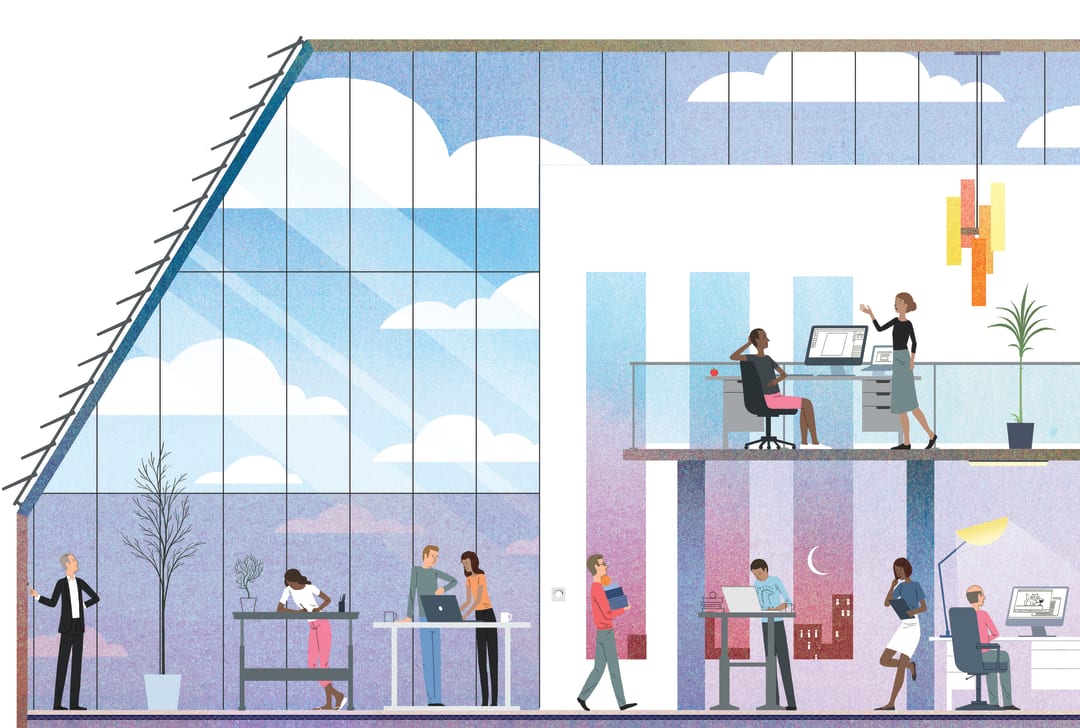Six design decisions that will entice clients and improve health
Published: January 28, 2017 | Updated: February 1, 2017

Quality of light is a major workplace stressor, as visible light will boost moods but too little can lead to fatigue.
Clients are ready for strategies that mitigate stress, increase happiness, and reduce costs
People spend 90 percent of their time indoors, and much of that time is spent at the office: an average of 47 hours per week. From lighting, to acoustics, to how much time we spend sitting, employees’ workplace experiences can impact their mental and physical well-being, even after they leave the office.
The good news is design decisions can increase health and happiness at work, and mitigate negative consequences of environmental stressors. According to Stanford University researchers, the effects of workplace stress are comparable to those of secondhand smoke. Long workdays and short deadlines contribute to long-term increased risk of cardiovascular disease, along with depression, anxiety, and short-term losses in productivity at work and at home.
Potential design clients are taking note. Nearly half of US companies are investing in workplace interventions to mitigate stress and improve well-being, including redesigning where we work. The WELL Building Standard and other emerging evidence-based tools and standards help architects design spaces that reduce stress and enhance physical and mental well-being. These three common workplace stressors can be resolved through six evidence-based strategies that help clients promote health and reduce costs.
WORKPLACE STRESSOR #1: Light
Adequate lighting is conducive to good health. It allows people to see color, perceive space, and perform tasks with ease and focus. But the quality of light in the workplace—both sunlight and artificial—matters. Diffuse ambient light or visible daylight may boost moods, while excessive or uneven light may lead to fatigue and visual discomfort.
Light affects people in nonvisual ways, too. Inadequate exposure to daytime sunlight and nocturnal light pollution over time are linked with increased risk of breast and prostate cancer. Therefore it is critical that workspaces provide regular access to natural light, feature lighting systems that consider circadian rhythms, and reduce sources of glare and visual discomfort.
1. Architects can reduce the effects of glare—stress-inducing excessive brightness—through strategic window sizing, operable controls, and electrochromic glass that reduce disruption without an overreliance on window shading.
2. Architects can use light models and other technologies to ensure adequate levels of equivalent melanopic lux—the parameter that indicates the impact of light on circadian rhythms—at workstations throughout the day, ensuring better rest at night.

Loud noises aren't just a distraction; they cost employers countless dollars in productivity and greatly increase stress.
WORKPLACE STRESSOR #2: Acoustics
Office noise is a leading source of dissatisfaction—and distraction—in the workplace. According to researchers at the University of California, Irvine, the modern office employee is interrupted every three minutes. These interruptions come at a cost: Interrupted workers require more effort to complete their work, and experience greater levels of stress.
And while it may be appealing for workers to cue up a Bach cello suite and don a pair of noise-canceling headphones, the long-term exposure may cause permanent hearing damage with no substantial gains in productivity.
3. Architects can provide their clients with a variety of “quiet” and “loud” zones to enable speech privacy—a leading concern among office workers—without impairing collaboration. An important first step is identifying and reducing noise emanating from mechanical systems and office equipment.
4. Architects can incorporate absorptive surfaces in order to reduce unwanted noise reverberation. Examples of sound-reducing treatments include wall panels, ceiling baffles, and other surface enhancements.

Workplaces are no longer primarily populated by middle-aged men in suits; it's time to update the temperature accordingly.
WORKPLACE STRESSOR #3: Temperature
Thermal comfort significantly affects how individuals feel and perform at work, and individual preferences can differ substantially from person to person. Yet many workplaces are optimized for middle-aged men in suits.
Variables such as humidity, air speed, metabolic rate, and clothing affect comfort, productivity, and stress levels. If it’s too warm, workers may experience headaches, eye and throat irritation, sweating, or an inability to focus on tasks. If it’s too cold, workers will often report feelings of discomfort.
5. Whether designing mechanically or naturally ventilated spaces, architects can work with engineers to balance workers’ personal comfort and the building’s energy efficiency, improving clients’ bottom lines.
6. Architects can provide areas with thermal gradients and personal controls to ensure that workers can find a space that meets their preferences.
Matt Welker, Assoc. AIA, is the senior manager of strategic alliances and initiatives at AIA.
Image credits

Michael Kirkham



